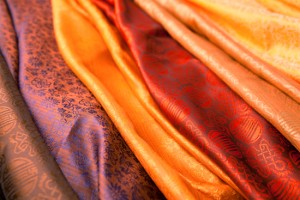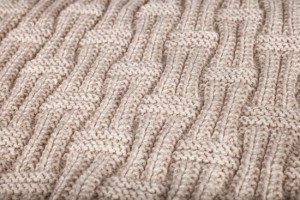Specialty Fabrics
 Wool and Silk are protein based fabrics, as opposed to cotton fabrics which are cellulose based.
Wool and Silk are protein based fabrics, as opposed to cotton fabrics which are cellulose based.
Protein based fabrics have a lot of positives. They have a unique feel or “hand.” They can keep you very warm as wool does or have a beautiful “drape” like silk. However, being made from proteins also carries with it the weaknesses of proteins.
Proteins are not very tolerant of high alkalinity, i.e. high pH. The protein structure will chemically breakdown and the fiber will weaken.
Proteins can also be chemically broken down by enzymes, specifically proteases. Many household laundry detergents use proteases to remove proteins based stains such as blood and grass stains. Unfortunately, proteases cannot tell the difference between stains and protein fibers and repeated, prolonged exposure of wool or silk to protease containing detergents is not recommended.
Protein wool fibers, when they are originally processed or “carded,” are stretched and aligned to create yarns and fabric. In the presence of water, especially hot water, the proteins fibers can open or swell. Add a little detergent and now the fibers can slide over each other. Add agitation, and we can tangle those fibers. As the fabric dries the swelled fibers close and lock the tangled fibers into place. The overall result is a denser mass of fibers which we see as shrinkage. To counter this, we use cooler water and hand-wash garments to reduce the amount of agitation. The garment is stretched back into the desired shape and allowed to air dry.
Protein wool fibers also have a natural source of lubrication, lanolin. A strong detergent will wash out this natural softener since lanolin looks a lot like other greases and oils that the detergent is meant to wash out. A mild detergent that is meant for cold water washing is recommended to minimize the loss of the lanolin.
Therefore, the basics of successfully cleaning protein based fabrics, especially wool, are to:
- hand-wash in a mild detergent
- use gentle agitation
- use, cool water
- lay out back into the desired shape
- allow the garment to air-dry.
Hot water, strong agitation and protease containing detergents should be avoided.
There are many internet suggestions of using hair shampoo, soap, homemade recipes and hand dish washing products to wash wool garments. It is our recommendation to stick with products that are specially formulated for wool or fine fabric care. The following list of common ingredients in these products will help illustrate this position.
Surfactants: These are the detergent ingredients that foam and remove soils. Retail formulators specifically chose and combine these ingredients for maximum cleaning in cool water with mildness. They also generally choose foamy ingredients as foam can “cushion” the garment during the cleaning process and reduce agitation and fiber tangling.
Chelants or Sequesterants: These are the water softening ingredients. Their function is to tie up the calcium and other hard water ions to prevent them from interfering with cleaning and also to prevent soap scum and scale. Shampoos and hand dishwashing detergents do not generally contain the optimum level of these ingredients for hand laundering.
Dispersants: Many retail fine fabric washes contain ingredients that disperse soils and any dyes that have come off the garment. It is important to keep these soils and dyes suspended so that they can be rinsed away instead of redepositing back onto the fabric. Shampoos and hand dishwash products do not contain these ingredients.
Optical Brighteners or Bluing Agents: These are optional ingredients that can prevent a garment from looking yellow or dingy after repeated laundering. Retail products can be found with and without brighteners.
Preservatives: These are ingredients used at low levels in fine fabric washes to keep the product functioning as it should during transportation and storage. A retail product can last for many months if stored properly. A “home-brew” is not professionally balanced in its ingredients, and since it usually does not contain any preservatives, it can “spoil” over time.
 Laundering of Wool Fabrics
Laundering of Wool Fabrics
Laundering of wool fabrics (a protein fiber) is best achieved using a different approach from that used on cotton and linen (cellulose fibers). To understand why, one must first consider the chemical structure of the fibers in question.
Cellulose consists of a series of glucose units linked together through positions 1 and 4 on the two adjoining glucose units. The functional group that provides this linkage is called an acetal. Acetals are stable in alkaline pH and unstable in acidic pH. As such most laundering is performed at a moderately alkaline pH. In addition to not harming the fabric fibers, the alkaline pH assists the cleaning by providing both alkalinity to chemically attack the soils and ionic strength to promote the surfactants migrating to the surface being cleaned.
By contrast, protein fibers consist of a series of amino acids linked together through the carboxylic acid functionality at position 1 and the amino functionality at position 2 on two adjoining amino acids. The functional group that provides this linkage is called an amide. Somewhat similar to acetals, amides are stable at moderate pH’s but are unstable at the pH extremes (they are unstable at very high pH’s and at very low pH’s). As stated above, laundering is routinely performed at a moderately alkaline pH, and, as such, we might anticipate that the protein fibers would not be harmed. And indeed, the attack on the amide linkages at the typical laundering pH is not significant. The main backbone of the protein fibers is stable to conventional laundry conditions.
However, protein fibers have a very significant amount of secondary structure provided by a variety of other functional groups within the protein fiber. It is this secondary structure that is susceptible to attack at the typical laundry pH. In other words, the conventional laundry conditions can cause the protein fiber to changes its shape without the backbone of the fiber necessarily breaking (hydrolysis of the amide groups to give the constituent amino acids). In theory, all of the necessary elements of the original secondary structure are still present, and so it might be possible to restore the original fiber structure. But, this is somewhat akin to thinking that we can put Humpty Dumpty back together again!
The solution to preserving this secondary structure, and thus the original shape of the wool item, is to use conditions that do not affect the secondary structure. This may be achieved by cleaning at neutral pH and at cool temperatures. Products that are designed for cleaning wool garments and fibers thus have neutral pH’s and have instructions to wash at cool temperatures.
Now that we understand the basics of the fiber structure and the key factors of pH and wash temperature, we can go a bit deeper into the composition of the detergent itself.
Surfactants
The main component of these detergents (and conventional detergents for that matter as well) are surfactants. Surfactants function by wetting, emulsifying and suspending the soils away from the fabrics being laundered. Common surfactants are sodium lauryl sulfate and linear alkyl benezesulfonic acid. (more on Surfactants)
Builders (or Sequestrants)
If laundering in hard water, the fabric is subject to encrustation by hardness deposits. Effectively the hardness deposits act as a series of small knives constantly cutting and tearing the fabric on a microscopic scale. Fabric encrustation is a significant problem that can lead to a much shortened fabric lifetime. Therefore, the typical laundry detergent also contains one or more builders (or also called sequestrants) to control the water hardness. Common names of builders used in laundry products are citrates and zeolites. These materials bind the calcium and magnesium ions in the wash water and thus allow the surfactants to work more efficiently. Without builders, the surfactants intended to clean the fabric may actually precipitate onto the fabric as calcium or magnesium salts. Builders are therefore especially critical in hard water conditions! (more on Builders)
Optical Brighteners
Optical brighteners are added to enhance the appearance of the fabrics. These are special molecules that absorb ultraviolet light from the sun and reflect them back as blue-white color. This low level of fluorescence helps hide the natural yellow color of most fibers and gives a white appearance to the fabrics. Fabric washed without optical brightener will eventually yellow and appear dingy. These are the materials that cause your fabrics to “glow” if you walk under a UV light in a disco!
Enzymes
There are typically 4 categories of enzymes that are used in cleaning products—proteases, lipases, amylases and cellulases.
Of the 4 categories of enzymes, the one used at the greatest concentration in most conventional laundry detergents are the proteases. Proteases are enzymes that specifically attack proteins. Proteases provide an efficient means of removing otherwise stubborn stains from fabric. These enzymes cleave the amides bonds that provide the backbone structure of proteins, allowing for easy removal of protein based stains such as grass stains and blood.
Interestingly, it should be noted that proteases do not distinguish between the protein molecules in a stain and proteins in a fiber. So, a conventional laundry detergent containing protease might be anticipated to be more detrimental to garments fashioned from protein fibers, such as wool, than a detergent that does not contain a protease. Therefore, detergents using proteases generally have lower pH’s to somewhat lessen this unwanted effect.
Lipases are enzymes that specifically attack fats and oils. They work by cleaving the ester bonds in into their constituent fatty acids and glycerol. (more on Enzymes)

